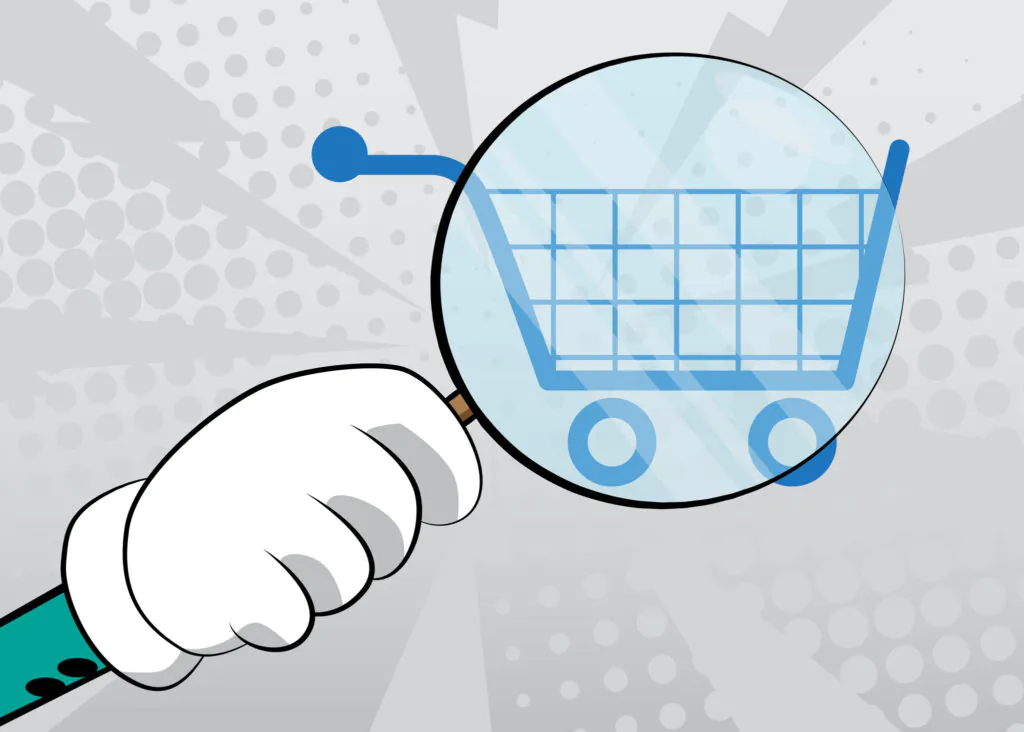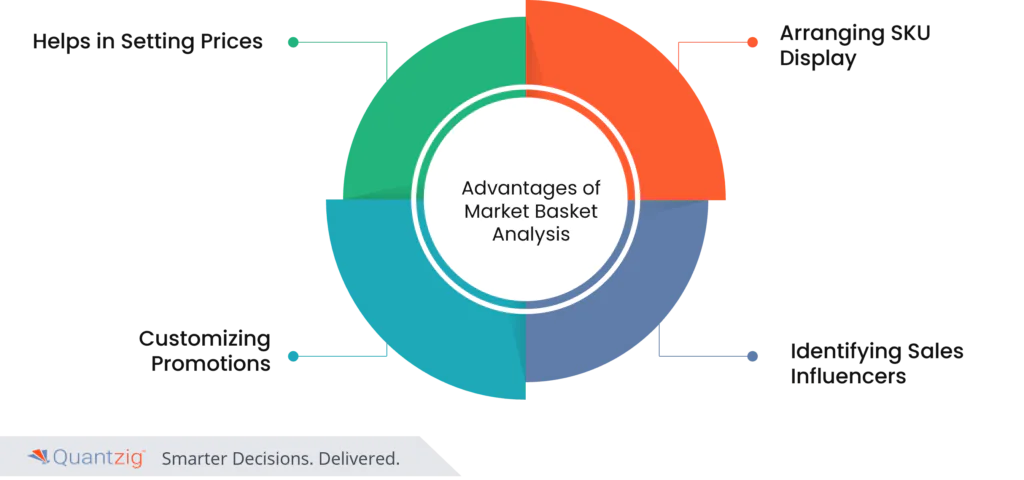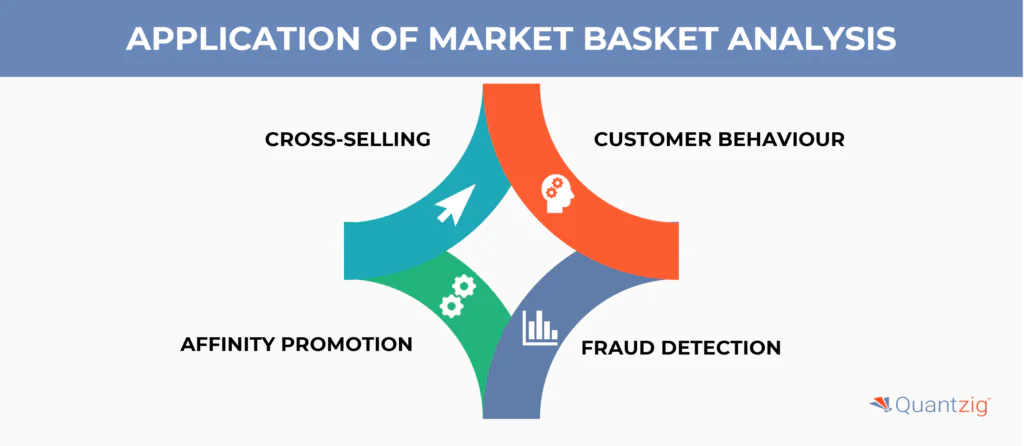Table of Contents
Introduction to Market Basket Analysis
Machine learning is proving to be highly advantageous for the retail sector, offering assistance across various functions such as customer identification and sales forecasting. Among the notable applications within retail, market basket analysis (MBA) stands out. MBA involves discerning patterns in customer purchases, enabling retailers to effectively arrange their physical stores and online platforms. By understanding which products are frequently bought together, businesses can optimize their offerings and enhance the shopping experience for customers. Additionally, MBA is not limited to retail; it is also utilized in areas such as detecting fraudulent credit card transactions and processing insurance claims.
Book a demo to experience the meaningful insights we derive from data through our analytical tools and platform capabilities. Schedule a demo today!
Request a Free DemoWhat is Market Basket Analysis?
Market basket analysis is a technique primarily used by retailers to understand customer purchasing patterns better in order to increase sales. Market basket analysis involves analyzing large datasets such as purchase history, customer buying behavior, to reveal valuable insights, such as product groupings, that optimize sales for retailers.
Market Basket Analysis (MBA) is a data mining approach aimed at understanding customer’s purchase behaviour by identifying pairs of products and uncovering patterns of co-occurrence. By analyzing transactions, businesses can discern common attributes among items frequently bought together. Utilizing these insights, organizations can develop effective marketing and sales strategies, optimize store layout, and boost consumer engagement. This ultimately leads to increased client satisfaction and drives sales and return on investment. Moreover, MBA assists in identifying opportunities to improve market share and optimize campaigns and promotions through techniques like Predictive Market Basket Analysis, regression, and Differential Market Basket Analysis.
The Objective of Market Basket Analysis
The main objective of market basket analysis is to identify products that customers want to purchase. Market basket analysis enables sales and marketing teams to develop more effective product placement, pricing, cross-sell, and up-sell strategies.
The objective of Market Basket Analysis (MBA) is to understand customer’s purchase behaviour by identifying common attributes and analyzing pairs of products that are frequently bought together. By uncovering patterns of co-occurrence within transactions, MBA enables businesses to develop effective marketing and sales strategies and optimize store layout to enhance the shopping experience. As a valuable data mining approach, MBA boosts consumer engagement and increases client satisfaction, ultimately leading to higher sales and return on investment. It also helps in identifying opportunities to improve market share and optimize campaigns and promotions. Furthermore, techniques such as Predictive Market Basket Analysis, regression, and Differential Market Basket Analysis provide deeper insights into purchasing trends and behavior.
Why Market Basket Analysis is Important?
In the retail sector, employing Market Basket Analysis (MBA) can yield a plethora of positive impacts for retailers. By scrutinizing customer behavior and discerning co-occurrence relationships between products, retailers can optimize their store layout and product placement to effectively organize products & combos, thereby influencing sales and revenue. Utilizing MBA, retailers can also leverage recommendation engines to provide personalized suggestions, catering to the interest of the customer and enhancing cross-selling and up-selling tactics. Furthermore, MBA aids in fraud detection by identifying fraudulent transactions through analysis of credit card usage patterns, ensuring the integrity of sales inventory and bolstering consumer trust. In today’s dynamic world of analytics, mastering data visualization and predictive modeling skills are essential for sales and marketing teams to capitalize on the power of data and gain a competitive advantage in the market.
For businesses striving to gain a winning edge, leveraging Market Basket Analysis (MBA) is paramount. MBA enables businesses to unlock invaluable insights into consumer behavior and purchasing patterns, facilitating competition analysis and enhancing the efficiency of sales and marketing efforts. By identifying patterns of consumer behavior and optimizing e-commerce methods and in-store activities, businesses can improve sales performance and solidify their market presence. MBA also aids in behavior analysis by analyzing transactions and credit or debit card history, empowering businesses to tailor marketing initiatives and strategies to meet customer needs. Ultimately, MBA serves as a strategic tool for aiding in improving customer comprehension, driving sales growth, and positioning businesses for sustained success in the ever-evolving retail environment.
Market Basket Analysis in the F&B Industry
Recent advancements in data analytics technology have opened up a world of possibilities for players in the food and beverage sector to increase their operational efficiency and delight their customers. The advancements have increased to such a level that data scientists have been able to create algorithms that accurately predict the next group of items you are about to buy based on a certain group of items that were previously purchased. For instance, people who buy beer and plastic mugs are more likely to buy chips as their next item.
Similarly, retailers can create relationships between specific items and accurately predict which items will be purchased next by assigning a certain level of probability. Market basket analysis can be used effectively to increase the overall spending from the customer by placing complimentary items close together or bundling such items at a discounted price.
Experience the advantages firsthand by testing a customized complimentary pilot designed to address your specific requirements. Pilot studies are non-committal in nature.
Request a Free PilotTypes Of Market Basket Analysis
1. Predictive Market Basket Analysis
This type uses supervised learning techniques such as regression and classification. It tries to mimic the market to see what factors impact outcomes. It figures out cross-selling by considering items purchased in a specific sequence.
2. Differential Market Basket Analysis
Competition analysis can benefit from this type of analysis. It compares purchase histories across different brands, time periods, seasons, days of the week, and so on, to uncover interesting patterns in consumer behavior.
Market Basket Analysis Benefits
1. Helps in Setting Prices
Market basket analysis helps a retailer to identify which SKUs are more preferred amongst certain customers. For instance, milk powder and coffee are frequently bought together, so analysts assign a high probability of association compared to cookies. Without market basket analysis retailers would usually markdown on coffee on certain days, assuming coffee will be sold at certain times. However, market basket analysis can point out that whenever a customer buys milk, they end up purchasing coffee as well. So whenever the sale of milk and coffee is expected to rise, retailers can mark down the price of cookies to increase the sales volume.
2. Arranging SKU Display
A common display format adopted across the supermarket chains is the department system, where goods are categorized as per department and sorted. For instance, groceries, dairy products, snacks, breakfast items, cosmetics, and body care products are properly classified and displayed in different sections. Market basket analysis helps identify items that have a close affinity to each other even if they fall into different categories. With the help of this knowledge, retailers can place the items with higher affinity close to each other to increase the sale. For instance, if chips are placed relatively close to a beer bottle, customers may almost always end up buying both. In contrast, if they were placed in two extremes, then the customer would just walk in the store buy beer and leave the store causing lost sales of chips.
3. Customizing Promotions
Marketers can study the purchase behavior of individual customers to estimate with relative certainty what items they are more likely to purchase next. Today, many online retailers use market basket analysis to analyze the customer’s purchase behaviour. Such retailers can estimate with certainty what items the individual may purchase at a specific time. For instance, a customer fond of barbecues would likely purchase meat and barbecue sauce on some weekends. So retailers can customize offers to create a combo of 2lbs of meat with one pack of barbecue sauce at a discounted price every weekend to increase his purchase frequency.
4. Identifying Sales Influencers
All items in a retail store have some relationship with each other – be it strong or weak. In most cases, the sale of one item is driven by the increase or decrease in the sale of other items. Market basket analysis can be used to study the purchasing trend of a certain SKU. Two SKUs can exhibit a strong affinity for a period of time and suddenly decrease because of various factors ranging from an increase in the price of one SKU, a new brand introduction, or the unavailability of a certain brand in the SKU. For instance, if Corona is the favorite beer among the consumers, and the brand is suddenly removed from the beer SKU, the sales of chips will go down as well, even though the sales of other beer brands are steady. This way marketers can understand the influence of such activities on the sales figure.
The benefits of Market Basket Analysis (MBA) are manifold. By delving into customer’s purchase behavior, MBA unveils common attributes and identifies pairs of products frequently bought together, revealing valuable patterns of co-occurrence. Utilizing these insights enables organizations to devise effective marketing and sales strategies tailored to consumer preferences, thus enhancing consumer engagement and driving increased sales and return on investment. Moreover, MBA aids in optimizing store layout to improve the overall shopping experience, consequently boosting client satisfaction. Through its data mining approach, MBA also assists in identifying opportunities to optimize market share and refine campaigns and promotions, leveraging techniques like Predictive Market Basket Analysis, regression, and Differential Market Basket Analysis.
Get started with your complimentary trial today and delve into our platform without any obligations. Explore our wide range of customized, consumption driven analytical solutions services built across the analytical maturity levels.
Start your Free Trial TodayHow Does Market Basket Analysis Work?
MBA offers numerous market basket analysis benefits for retailers and businesses alike. By leveraging machine learning and analyzing big data sets, MBA enables retailers to gain insights into customer behavior and optimize their store layout and product placement. This optimization enhances sales and revenue by effectively organizing products & combos and implementing cross-selling and up-sell tactics. Moreover, MBA aids in fraud detection by identifying fraudulent transactions and analyzing credit card usage, ensuring the integrity of sales inventory and bolstering consumer trust. Overall, MBA serves as a powerful tool for businesses to improve sales performance, understand client buying habits, and drive market presence in the competitive retail sector.
The IF, THEN structure is utilized in association rule mining to imitate market basket analysis. When a customer purchases bread, they are inclined to also buy butter. Illustrations of association rules entail “Bread” -> “Butter”.
Learn the ensuing definitions to better grasp market basket analysis:
1. Antecedent
The entities or “itemsets” derived from the data are termed antecedents. In other words, it’s the IF component on the left side. In the prior case, bread functions as the antecedent.
2. Consequent
The phrase “consequent” denotes an item or collection of items that transpire along with the antecedent. The THEN segment of the sentence is exhibited on the right side. The outcome in the aforementioned illustration is butter.
APPLICATION OF MARKET BASKET ANALYSIS:
The application of Market Basket Analysis (MBA) spans across various domains within retail and beyond. By analyzing customer’s purchase behavior, MBA uncovers common attributes and identifies pairs of products frequently bought together, revealing significant patterns of co-occurrence. This information is instrumental in developing effective marketing and sales strategies tailored to consumer preferences, thereby driving increased sales and return on investment. Moreover, MBA aids in optimizing store layout, leading to enhanced consumer engagement and client satisfaction. Its data mining approach also assists in identifying opportunities to improve market share and refine campaigns and promotions through techniques like Predictive Market Basket Analysis, regression, and Differential Market Basket Analysis.
1. CROSS-SELLING:
Businesses have various definitions of cross-selling based on different factors. Simply put, cross-selling is a strategy where a seller recommends additional related products to customers who have already bought the main product. An MBA degree helps retailers comprehend customer behavior and then implement cross-selling.
2. CUSTOMER BEHAVIOUR:
Customer behavior broadly examines how people, either individually or in groups, acquire goods and services to fulfill their desires and requirements. As I noted previously, market basket analysis aids in comprehending consumer actions. It offers perspective into customer purchasing patterns, assisting retailers in identifying associations between two items that a customer is inclined to buy together.
3. AFFINITY PROMOTION:
Affinity promotion is a technique that utilizes data analytics to uncover associations between items purchased by particular people or groups. By comprehending customer purchasing patterns, companies can make decisions about cross-selling, loyalty programs, store layouts, and discount plans. Affinity promotion enables organizations to identify items frequently bought together so they can promote related or complementary products to customers. This method provides insights into customer behavior that allow businesses to tailor merchandising, promotions, and offers. The goal is to increase sales by revealing connections between products that shoppers are likely to purchase together.
4. FRAUD DETECTION:
Market Basket Analysis can also be used to detect fraud. It can identify fraudulent transactions by understanding how customer behavior differs under various conditions. For example, analyzing credit card usage data can uncover fraud linked to purchasing patterns.
Beyond its popularity for retailers, Market Basket Analysis has many other applications like bioinformatics, finance, etc. Bioinformatics in simple terms involves collecting, classifying, and analyzing biological and biochemical data to prescribe medications to different patient groups.
In finance, retailers can compile various information and use Market Basket Analysis to detect fraud, segment customers, and more.
In summary, Market Basket Analysis is becoming an essential tool for all organizations to uncover associations and hidden relationships between products, which in turn boosts their market presence. Yet there remains much-undiscovered potential for Market Basket Analysis to be leveraged.
Conclusion
Leverage Quantzig’s marketing analytics solutions to look for patterns, application of market basket analysis, benefits of market basket analysis, trends, and valuable insights in your data and understand customer sentiments better. With Quantzig’s market-based analysis solutions, increase efficiency and realize better returns on your marketing spending by optimizing campaign planning and implementation, effectively use multi-channel and omni-channel marketing, increase conversions, and drive maximum brand loyalty.







